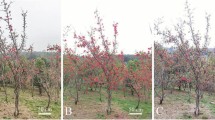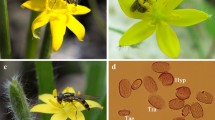Abstract
Pollination mechanisms within the genusCampanula were studied. Tests were undertaken to examine whether in vitro culture of pollen grains can serve as a useful tool for understanding the self- and cross-pollination mechanisms among species. Characteristics of pollen germination were interpreted in relation to mating system and floral biology. Four annual species (Campanula kremeri, C. dichotoma, C. afra, C. lusitanica), and two perennial species (C. rotundifolia andC. persicifolia) were investigated. In the annual species pollen germinability is controlled by (1) the age of pollen and/or (2) in what position pollen is deposited around the style. Correlations were found between pollen germinability and mating system in three of the four annual species. No correlations were found either between germinability and age of pollen or position on the style in the perennial species. Pollen germinability reached its maximum in the middle of the male phase in all species, except forC. dichotoma, which had a decreasing germinability throughout anthesis. The germinability was lowest at the time of stigma receptivity for all species except forC. persicifolia, where the stigma did not develop as long as pollen remained on the style. The pollen collecting hairs and pollen removal have been found to play an important role controlling the stigma development, thus affecting self-pollination. This was especially pronounced inC. persicifolia. Further studies will be undertaken to elucidate factors influencing pollination within the genusCampanula.
Similar content being viewed by others
References
Baker, H. G., 1966: The evolution, functioning, and breakdown of heteromorphic incompatibility systems. I. ThePlumbaginaceae. — Evolution20: 349–368.
Beck, W. A., Joly, R. A., 1941: Some growth phenomena in cultured pollen tubes. — Trans. Amer. Microsc. Soc.60: 149–162.
Brewbaker, J. L., Majumder, S. K., 1961: Cultural studies of the pollen population effect and the self-incompatibility inhibition. — Amer. J. Bot.48: 457–464.
—, 1963: The essential role of calcium ion in pollen germination and pollen tube growth. — Amer. J. Bot.50: 859–865.
Brink, R. A., 1924a: The physiology of pollen. I. The requirements for growth. — Amer. J. Bot.11: 218–228.
—, 1924b: The physiology of pollen. IV. Chemotropism, effects on growth of grouping grains, formation, and function of callose plugs, summary, and conclusions. — Amer. J. Bot.11: 417–436.
Cook, S. A., Stanley, R. G., 1960: Tetrazolium chloride as an indicator of pine pollen germinability. — Silvae Genet.9: 134–136.
Dahl, Å., 1989: Taxonomic and morphological studies inHypecoum sect.Hypecoum (Papaveraceae). — Pl. Syst. Evol.163: 227–280.
Ganeshaiah, K. N., Uma Shaanker, R., Shivashankar, G., 1986: Stigmatic inhibition of pollen grain germination—its implication for frequency of seed number in pods ofLaucaena leucocephala (Lam.)de Wit. — Oecologia (Berlin)70: 568–572.
Herrero, M., Arbeloa, A., 1989: Influence of the pistil on pollen tube kinetics in peach (Prunus persica). — Amer. J. Bot.76: 1441–1447.
Horowitz, A., Harding, J., 1972: Genetics ofLupinus. V. Intraspecific variability for reproductive traits inLupinus nanus. — Bot. Gaz.133: 155–165.
Juncosa, A. M., Webster, B. D., 1989: Pollination inLupinus nanus subsp.latifolius (Leguminosae). — Amer. J. Bot.76: 59–66.
Kendall, W. A., 1967: Growth of red clover pollen. II. Elongation in vitro. — Crop. Sci.7: 342–344.
Linck, A. J., Blaydes, G. W., 1960: Demonstration of the chemotropism of pollen tubes in vitro in four plant species. — Ohio J. Sci.60: 274–278.
Miller, M. K., Schonhorst, M. H., 1968: Pollen growth of alfalfa in vitro as influenced by grouping of grains on the medium and greenhouse versus field sources. — Crop. Sci.8: 525–526.
Norton, J. D., 1966: Testing of plum pollen viability with tetrazolium salts. — Proc. Amer. Soc. Hort. Sci.89: 132–134.
Nyman, Y., 1991: Crossing experiments within theCampanula dichotoma group (Campanulaceae). — Pl. Syst. Evol.177: 185–192.
Oberle, G. D., Watson, R., 1953: The use of 2,3,5-triphenyl tetrazolium chloride in viability tests of fruit pollen. — Proc. Amer. Soc. Hort. Sci.61: 299–303.
Rajora, O. P., Zsuffa, L., 1986: Pollen viability of somePopulus species as indicated by in vitro pollen germination and tetrazolium chloride staining. — Canad. J. Bot.64: 1086–1088.
Rice, J. S., Wang, C. L., Gray, E., 1970: Relationship of pollen and pistil characteristics with self- and cross-compatibility in alfalfa. — Crop Sci.10: 59–61.
Rosen, W. G., 1961: Studies on pollen tube chemotropism. — Amer. J. Bot.48: 889–895.
Schaal, B. A., Leverich, W. J., 1980: Pollination and banner markings inLupinus texensis (Leguminosae). — Southw. Naturalist25: 280–282.
Schemske, D. W., Lande, R., 1985: The evolution of self-fertilization and inbreeding depression in plants. II. Empirical observations. — Evolution39: 41–52.
Shetler, S. G., 1958: The taxonomy and ecology ofCampanula americana L. in the Laurel Hill region of Pennsylvania. — M. S. Thesis, New York: Cornell University, Ithaca.
—, 1979: Pollen-collecting hairs ofCampanula (Campanulaceae), I: Historical review. — Taxon28: 205–215.
Shipe, E. R., Quesenberry, K. H., Gray, E., 1971: Influence of excised pistils on in vitro growth of alfalfa pollen. — Crop Sci.11: 398–399.
Stebbins, G. L., 1958: Longevity, habitat, and release of genetic variability in the higher plants. — Cold Spring Harbor Symp. Quant. Biol.23: 365–378.
Strandhede, S.-O., 1966: Morphologic variation and taxonomy in EuropeanEleocharis, subser.Palustres. — Opera Bot.10: 1–187.
Visser, T., 1955: Germination and storage of pollen. — Meded. Landbouwhogesch. Wageningen55: 1–68.
Wyatt, R., 1984: The evolution of self-pollination in granite outcrop species ofArenaria (Caryophyllaceae). I. Morphological correlates. — Evolution38: 804–816.
Author information
Authors and Affiliations
Rights and permissions
About this article
Cite this article
Nyman, Y. Pollination mechanisms in sixCampanula species (Campanulaceae). Pl Syst Evol 181, 97–108 (1992). https://doi.org/10.1007/BF00937589
Received:
Revised:
Accepted:
Issue Date:
DOI: https://doi.org/10.1007/BF00937589




